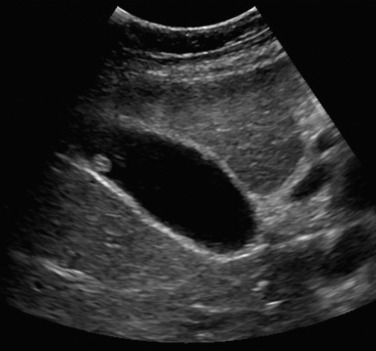Physical Address
304 North Cardinal St.
Dorchester Center, MA 02124
Focal gallbladder wall thickening is often an imaging diagnosis and encompasses a wide variety of differential diagnoses. Polypoid lesions of the gallbladder form an important group of conditions that are included in the differential diagnosis of focal gallbladder wall thickening and can be divided into neoplastic and non-neoplastic groups ( Figure 57-1 ). The neoplastic group includes adenomas, leiomyomas, neurofibromas, and gallbladder carcinoma. The non-neoplastic group includes lesions such as cholesterol polyps, inflammatory polyps, adenomyoma, and focal xanthogranulomatous cholecystitis (XGC) ( Box 57-1 ).
The majority of gallbladder adenomas are associated with cholelithiasis (50% to 65%). An increased incidence of gallbladder adenomas and biliary tract adenomas are seen in familial adenomatous polyposis and Peutz-Jeghers syndrome.
Gallbladder adenomas are uncommon lesions, found in 0.5% of cholecystectomy specimens. A small proportion of the gallbladder adenomas can progress to carcinoma, and approximately 10% are multiple.
Gallbladder adenomas are usually asymptomatic and incidentally discovered. Large adenomas or sometimes small adenomas can obstruct the cystic duct and cause right upper quadrant pain.
The most common variant is a tubular adenoma. They appear as polypoid structures that project into the gallbladder lumen and may be sessile or pedunculated and generally less than 2 cm.
Gallbladder polyps with a stalk and a diameter less than 10 mm are predominantly benign. Sessile polyps and those greater than 10 mm in diameter have a higher likelihood of harboring malignancy and are often an indication for elective cholecystectomy. Adenomas obstructing the cystic duct may lead to gallbladder hydrops or cholecystitis.
Gallbladder adenomas are seen as intraluminal soft tissue masses that are isoattenuating or hypoattenuating relative to the liver on contrast-enhanced CT ( Table 57-1 ). These intraluminal masses are difficult to distinguish from noncalcified gallstones on CT, and ultrasonography often helps.
| Modality | Accuracy | Limitations | Pitfalls |
|---|---|---|---|
| Radiography | Data not available to specify accuracy | Insensitive Nonspecific |
Unable to directly visualize the soft tissues of gallbladder |
| CT | Data not available to specify accuracy | Radiation exposure Not ideal in pregnant patients |
CT may not differentiate noncalcified gallstones from adenomas |
| MRI | Data not available to specify accuracy | Expensive | |
| Ultrasonography | Data not available to specify accuracy | Operator dependent | Differentiation from gallstones adherent to the wall may be difficult |
| Nuclear medicine | Data not available to specify accuracy No role in imaging of adenomas |
||
| PET/CT | Data not available to specify accuracy | Decreased sensitivity in patients with diabetes | Differentiation from gallbladder cancer is not always possible |
Polyps are usually seen as homogeneous and low to intermediate signal intensity on T1- and T2-weighted images. Contrast enhancement is seen on delayed images.
The lesions appear as smoothly marginated, intraluminal polypoid masses with an occasional lobulated or cauliflower-like contour ( Figure 57-2 ). There is a homogenous hyperechoic echotexture, but the echogenicity decreases with increasing size and large adenomas may have a heterogeneous appearance.

The adjacent gallbladder wall characteristically maintains a normal thickness of less than 3 mm. Focal gallbladder wall thickening adjacent to a polypoid mass increases the probability of malignancy.
Gallstones are common in patients with gallbladder adenomas.
Positron emission tomography (PET) is not usually indicated in the diagnosis of adenomas. However, it has a potential application in ruling out malignancy within a polypoid lesion in the gallbladder.
A smoothly marginated polypoid, sessile, or pedunculated lesion projects into the gallbladder lumen.
Cholelithiasis is a common association.
These lesions are usually asymptomatic and thus detected incidentally. Adenomas obstructing the cystic duct may present with symptoms of acute cholecystitis (see Chapter 56 ). Gallstones are differentiated based on mobility and adherence to the gallbladder wall. Gallbladder carcinoma has a heterogeneous internal architecture with mucosal irregularity, adjacent parenchymal liver invasion, biliary duct dilatation, metastases, and lymphadenopathy.
Because of their malignant potential, cholecystectomy is recommended for gallbladder adenomas larger than 10 mm.
These benign lesions are uncommonly associated with cholelithiasis and cholesterolosis.
Cholesterol polyps are benign lesions with no malignant potential that account for approximately 50% of the polypoid lesions in the gallbladder. They predominantly occur in women in their fifth or sixth decades.
Usually asymptomatic, these polyps are typically found in patients who are being evaluated for epigastric discomfort and right upper quadrant pain.
The cholesterol polyps are composed of lipid-laden macrophages and are covered by normal gallbladder epithelium that can invaginate and form gland-like structures. They can be single or multiple and usually are less than 10 mm in diameter.
Cholesterol polyps are incidental findings on imaging ( Table 57-2 ).
| Modality | Accuracy | Limitations | Pitfalls |
|---|---|---|---|
| Radiography | Data not available to specify accuracy | Insensitive Nonspecific |
Unable to directly visualize the soft tissues of gallbladder |
| CT | Data not available to specify accuracy | Radiation exposure Not ideal in pregnant patients |
Identification is difficult because the polyps have attenuation similar to bile Differentiation from floating stones and tumefactive sludge can be difficult. |
| MRI | Data not available to specify accuracy | Expensive | |
| Ultrasonography | Data not available to specify accuracy | Operator dependent | |
| Nuclear medicine | Data not available to specify accuracy No role in imaging of adenomas |
||
| PET/CT | Data not available to specify accuracy | Decreased sensitivity in patients with diabetes |
Become a Clinical Tree membership for Full access and enjoy Unlimited articles
If you are a member. Log in here